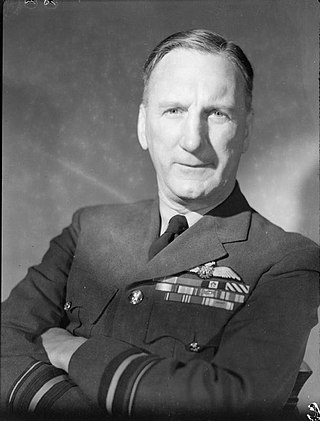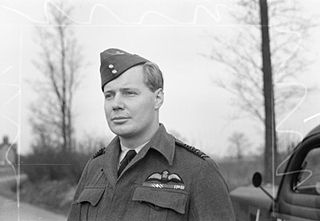
Marshal of the Royal Air Force William Sholto Douglas, 1st Baron Douglas of Kirtleside, was a senior commander in the Royal Air Force. After serving as a pilot, then a flight commander and finally as a squadron commander during the First World War, he served as a flying instructor during the inter-war years before becoming Director of Staff Duties and then Assistant Chief of the Air Staff at the Air Ministry.

Air Chief Marshal Lloyd Samuel Breadner, CB, DSC was a Canadian military pilot and Chief of the Air Staff during World War II.

Marshal of the Royal Air Force Arthur William Tedder, 1st Baron Tedder, was a Scottish Royal Air Force officer and peer. He was a pilot and squadron commander in the Royal Flying Corps in the First World War and he went on to serve as a senior officer in the Royal Air Force (RAF) during the inter-war years when he served in Turkey, Great Britain and the Far East.

Marshal of the Royal Air Force Sir Andrew Henry Humphrey, was a senior officer in the Royal Air Force. He fought in the Second World War as a fighter pilot taking part in the Battle of Britain and also took part in the withdrawal from Aden in November 1967. He served as the Chief of the Air Staff advising the new Labour Government on the implementation of their latest Defence Review. He then served as Chief of the Defence Staff but caught pneumonia within three months of taking office and died shortly afterwards.

Marshal of the Royal Air Force Sir Dermot Alexander Boyle, was a senior officer in the Royal Air Force. He served in the Second World War initially as a staff officer with the Advanced Air Striking Force in Reims in which capacity he organised the evacuation of the Force through Brest in May 1940. His war service included tours as a bomber squadron commander, as a station commander and also as an air group commander. He was Chief of the Air Staff in the late 1950s and, in that role, deployed British air power during the Suez Crisis in October 1956 and defended the RAF against the views of Duncan Sandys, the Minister for Defence, who believed that the V bomber force rendered manned fighter aircraft redundant.

Marshal of the Royal Air Force Sir John Grandy, was a senior officer in the Royal Air Force. He was the only officer who fought and commanded a squadron during the Battle of Britain to reach the post of Chief of the Air Staff. In the latter role he implemented the final stages of the RAF's withdrawal from the Persian Gulf and the Far East, oversaw the ordering and subsequent cancellation of the F-111 strike aircraft and handed over Britain's nuclear deterrent role to the Royal Navy.

Marshal of the Royal Air Force Neil Cameron, Baron Cameron of Balhousie, was a senior officer in the Royal Air Force. He fought in the Second World War as a fighter pilot taking part in the Battle of Britain, the Battle of Alam el Halfa, the First Battle of El Alamein and the Second Battle of El Alamein and then in operations in Burma. He served as Chief of the Air Staff in the late 1970s advising the British Government on the reinforcement of the British garrison in Belize which was under threat from Guatemala at the time. He also served as the Chief of the Defence Staff at the end of the 1970s in which role he secured pay comparability for services personnel involved in civil support during the firemen's strike, visited the People's Republic of China and lectured extensively on the Soviet air threat.

Marshal of the Royal Air Force Sir Denis Frank Spotswood, was a senior commander in the Royal Air Force. He fought in the Second World War as a flying boat pilot and then as a coastal reconnaissance squadron commander during Operation Torch, the invasion of North Africa. He served as a station commander in the late 1940s and early 1950s before becoming a senior air commander in the late 1950s. As the Chief of the Air Staff in the early 1970s he had a major role in implementing the defence savings demanded by the Heath Government in the face of economic difficulties at the time.

Air Chief Marshal Sir Harry Broadhurst,, commonly known as Broady, was a senior Royal Air Force commander and flying ace of the Second World War.

Air Chief Marshal Sir George Holroyd Mills, was a senior Royal Air Force commander. After his retirement from the RAF, Mills served as Black Rod in the Houses of Parliament until 1970. He was also a trustee of the Imperial War Museum.

Air Chief Marshal Sir Christopher Hugh Moran, was a fast jet pilot and later a senior commander in the Royal Air Force. He was Commander-in-Chief of Air Command at the time of his unexpected death.

Air Vice-Marshal Sir Edward Hedley "Mouse" Fielden, was a senior Royal Air Force commander and a pilot of the Second World War.

Air Marshal Sir Harold Brownlow Morgan "Micky" Martin, was an Australian bomber pilot and senior commander in the Royal Air Force (RAF). He took part in Operation Chastise, the RAF's "Dambusters" raid in 1943, and was described by journalist Sir Max Hastings as "one of the three great bomber pilots of the war". He rose to become a senior officer in the RAF, commanding RAF Germany and later serving as Air Member for Personnel, a member of the Air Council, the RAF's controlling body.
Air Vice Marshal Sir Brian Gerald Tivy Stanbridge, was a senior Royal Air Force officer.

Air Marshal Sir Leonard Horatio Slatter, was a naval aviator during the First World War and a senior Royal Air Force commander during the Second World War. Slatter ended his career as the Air Officer Commanding-in-Chief of Coastal Command.
Air Chief Marshal Sir George Clark Pirie, was a senior commander in the Royal Air Force during the Second World War and the immediate post-war years. During the First World War, Pirie served as an infantry officer before transferring to the Royal Flying Corps where he took up duties as an observer officer.

Air Marshal Sir Peter Guy Wykeham, was a Royal Air Force fighter pilot and squadron commander, and a flying ace of the Second World War. He was credited with 14 and 3 shared aerial victories.

Air Chief Marshal Sir Francis Joseph Fogarty, was a senior commander in the Royal Air Force (RAF) during the Second World War and also in the post-war years. During the First World War he served as a pilot in the Royal Flying Corps. He was transferred to the RAF on its creation in 1918 and remained in the service during the inter-war years.

Air Vice Marshal Wilfred Ashton McClaughry,, born Wilfred Ashton McCloughry, was an Australian aviator and air commander who served in the Australian Flying Corps during the First World War and Royal Air Force in the Second World War. His senior commands included: British Forces Aden (1930s), and; No. 9 Group RAF, and Air Officer Commanding Air Officer Commanding Allied Headquarters Egypt. McClaughry was killed, while a passenger, in a flying accident in Cairo in 1943.
Air Marshal Sir Ivor Gordon Broom, was a senior Royal Air Force commander, and a decorated bomber pilot of the Second World War.

















